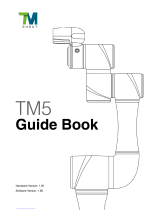
Table of Contents
RC700-A option TP3 Rev.11 vii
3.2.4 Current Position ............................................................................ 50
3.2.5 Current Arm Orientation ............................................................... 50
3.2.6 Jog Distance ................................................................................. 50
3.2.7 Registering the Robot Position ..................................................... 51
3.2.8 Command ..................................................................................... 51
3.2.9 Jog Key Guide .............................................................................. 52
3.3 Programming ............................................................................................ 53
3.3.1 Current Project Management ....................................................... 53
3.3.2 Program Editing ............................................................................ 54
3.3.3 Point File Management ................................................................ 54
3.3.4 Point Data Editing ......................................................................... 54
3.4 Test ............................................................................................................ 56
3.4.1 Single-task Program Verification .................................................. 57
3.4.2 Multi-task Program Verification .................................................... 59
3.4.3 TEST Mode Operation Method .................................................... 62
3.5 Robot Parameters ..................................................................................... 63
3.5.1 Local Coordinate System Setting ................................................. 63
3.5.2 Tool Coordinate System Setting ................................................... 64
3.5.3 Additional Arm setting ................................................................... 65
3.6 Direct Teach .............................................................................................. 66
3.6.1 Coordinate System ....................................................................... 67
3.6.2 Current Position ............................................................................ 67
3.6.3 Current Arm Orientation ............................................................... 67
3.6.4 Force Setting ................................................................................ 68
3.6.5 Teaching ....................................................................................... 70
4. TEACH/T2 Mode 72
4.1 Test (T2) .................................................................................................... 73
5. AUTO Mode 74
5.1 Operator Panel.......................................................................................... 75
5.1.1 Program Execution ....................................................................... 76
5.2 Maintenance ............................................................................................. 77
5.2.1 Backup .......................................................................................... 77
5.2.2 Restore ......................................................................................... 78
5.2.3 Controller Maintenance ................................................................ 79
5.2.4 Robot Maintenance ...................................................................... 80
5.3 Configuration ............................................................................................. 81
5.3.1 Preferences .................................................................................. 81
5.3.2 System Information ...................................................................... 82
5.3.3 Update Software ........................................................................... 82
5.3.4 Shutdown ...................................................................................... 83
6. Password Setup 84






















